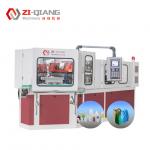A. Ultimate energy consumption control, reducing unit production
costs
Dynamic energy consumption adjustment technology: The equipment can
automatically match the power according to the production stage -
the injection molding stage (high load) automatically switches to
"full power mode" (motor output power 80%-100%); the low-load stage
such as cooling and material collection switches to "energy saving
mode" (power reduced to 30%-40%). For example, when producing 500ml
mineral water bottles, the energy consumption of a single mold can
be controlled at 0.08-0.12kW・h (conventional injection blow molding
machine is about 0.15-0.2kW・h). Based on a daily production
capacity of 100,000 pieces, 500-800kW・h of electricity can be saved
per day.
Reuse of waste heat: The waste heat generated by barrel heating
(temperature of about 80-120℃) can be collected through pipelines
and used to preheat raw materials (heating raw materials from room
temperature to 40-50℃), reducing the energy consumption required
for barrel heating (reduced by about 15%-20%); at the same time,
the hot water (temperature of about 60-70℃) of the cooling system
can be recycled to the workshop hot water supply system (such as
hot water for cleaning molds), realizing "energy cascade
utilization".
B. Humanized design to reduce the threshold of operation and
maintenance
Visual operation and fault diagnosis: Equipped with a 10-15-inch
touch screen (supporting multi-touch), the operation interface
adopts "icon + step-by-step guidance" design (such as the
"injection parameter setting" interface marks the function and
recommended range of each parameter), and novices can operate
independently after 1-2 days of training. When the equipment fails
(such as mold jamming, sensor failure), the system will display
"fault code + 3D disassembly diagram" (such as "E023: ejector
stuck", with ejector mechanism disassembly steps), and maintenance
personnel can check according to the diagram, and the average
troubleshooting time is shortened to less than 30 minutes
(traditional equipment takes 1-2 hours).
Safety protection upgrade: "Double safety protection" is set on the
periphery of the equipment - the outer layer is a transparent UV
protection cover (which can observe the production status and block
the high temperature radiation of the mold), and the inner layer is
an infrared sensor (sensing distance 5-10cm). When the human body
is close to the mold movement area, the equipment will stop in 0.1
seconds (braking distance ≤5mm) to avoid mechanical damage; at the
same time, high-temperature parts such as hoppers and barrels are
wrapped with insulation layers (surface temperature ≤50℃) to
prevent operators from accidentally touching and scalding.
C. Modular expansion of functions to meet diverse needs
Quickly upgrade to be compatible with new processes: functions can
be expanded through "module replacement" - for example, by adding a
"rotary demoulding module", products with built-in threads (such as
cosmetic bottle caps) can be produced; by adding a "multi-layer
co-extrusion module", it can be upgraded to a "multi-layer
injection blow molding machine" to produce composite products with
a barrier layer (anti-penetration) and a light-shielding layer
(anti-ultraviolet) (such as pesticide bottles, essential oil
bottles). The upgrade process does not require the replacement of
the host, and the cost is only 30%-40% of the purchase of new
equipment.
Adapt to small and large products: Not only can it produce products
of conventional sizes (10-2000ml), but it can also cover more
extreme sizes by replacing molds and adjusting process parameters -
for example, a micro injection blow molding machine can produce
0.5-5ml medicinal ampoules (accuracy of ±0.01mm); a large injection
blow molding machine can produce 5-20L chemical barrels (wall
thickness uniformity ±0.1mm), and no segmented molding is required
(traditional large products require two injection molding + blow
molding).










